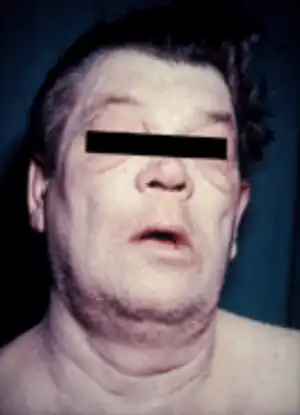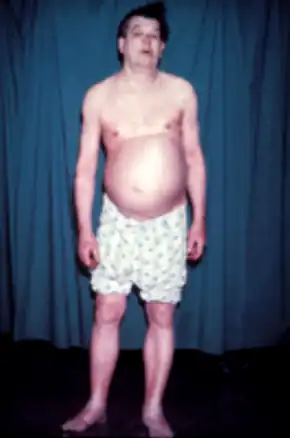Myxedema coma
| Myxedema coma | |
|---|---|
 | |
| Face of someone with myxedema showing an expressionlessness, periorbital puffiness, and pallor | |
| Specialty | Endocrinology |
| Symptoms | Altered mental status, low body temperature[1] |
| Complications | Respiratory failure[2] |
| Usual onset | Older females[1] |
| Risk factors | Untreated hypothyroidism[1] |
| Diagnostic method | Based on symptoms together with lab tests[2] |
| Differential diagnosis | Sepsis, seizure, diabetic ketoacidosis, overdose[2] |
| Treatment | Levothyroxine (T4), hydrocortisone, antibiotics[1] |
| Frequency | Rare[2] |
| Deaths | 20 to 50% of cases[1] |
Myxedema coma is a decompensated form of hypothyroidism.[1] Typical symptoms include altered mental status and low body temperature.[1] Other symptoms may include sleep apnea, puffy skin, hair loss, and abdominal bloating.[2] Coma; however, is not typically present.[1] Complications may include respiratory failure.[2]
It generally occurs in those with hypothyroidism that is severe and untreated.[1] Often an event such as dehydration, infection, or stroke triggers its development.[1][2] Laboratory tests typical show a low thyroid state (low free T4 and high TSH).[1] Other finding may include low blood pressure, slow heart rate, slow reflexes, low sodium, and low blood sugar.[1]
Early treatment with thyroid hormone is key.[1] This is generally given as a 300 to 500 ug intravenous dose of levothyroxine (T4), though some also use liothyronine (T3).[1] Hydrocortisone 100 mg and antibiotics are also often given.[1] While warming a person by giving heating intravenous fluids is reasonable, there are concerns that just warming a persons skin could further lower their blood pressure.[1] Risk of death is about 20 to 50%.[1]
Myxedema coma is rare affected about 1 in 5 million people per year.[2] Those affected are usually older and female.[1] Onset is often in the winter.[1] The condition was initially described by Ord in 1879.[3]
Signs and symptoms

- Cardiovascular
- Bradycardia
- Bundle branch blocks
- Complete heart block and arrhythmias
- Cardiomegaly
- Elevated diastolic blood pressure—early
- Hypotension—late
- Low cardiac output
- Non-specific ECG findings
- Pericardial effusion
- Polymorphic ventricular tachycardia (torsades de pointes)
- Prolonged QT interval
- Respiratory
- Hypoxia
- Hypercarbia
- Hyperventilation
- Myxedema of the larynx
- Pleural effusion
- Gastrointestinal
- Abdominal distention
- Abdominal pain
- Anasarca
- Anorexia and nausea
- Decreased motility
- Fecal impaction and constipation
- Gastric atony
- Myxedema or toxic megacolon—late
- Neurogenic oropharyngeal dysphagia
- Paralytic ileus
- Neurological
- Altered mentation
- Coma
- Confusion and obtundation
- Delayed tendon reflexes
- Depression
- Poor cognitive function
- Psychosis
- Seizures
- Renal and urinary function
- Bladder dystonia and distension
- Fluid retention
- Appearance and dermatological
- Alopecia
- Coarse, sparse hair
- Dry, cool, doughy skin
- Myxedematous face
- Generalized swelling
- Goiter
- Macroglossia
- Non-pitting edema
- Ptosis
- Periorbital edema
- Surgical scar from prior thyroidectomy
- Hypothermia
Pathophysiology
Precipitating factors of myxedema coma include:[4][5][6]
- Medications
- Burns
- Carbon dioxide retention or hypercapnia
- Cold exposure
- Gastrointestinal bleeding
- Low blood sugar or hypoglycmia
- Low body temperature or hypothermia, especially during winter months
- Low oxygen levels or hypoxia
- Infection
- Stroke or cerebrovascular accidents
- Surgery (given the effect on pituitary-thyroid axis with decrease thyroid hormones secretion after surgery in response to stress)
- Trauma
- Motor vehicle accidents
- Fractures
- Congestive heart failure
- Consumption of raw bok choy
- Diabetic ketoacidosis (DKA) after total thyroidectomy.
Diagnosis
- Anemia
- Elevated creatine kinase (CPK)
- Elevated creatinine
- Elevated transaminases
- Hypercapnia
- Hypercholesterolemia (elevated LDL)
- Hyperlipidemia
- Hypoglycemia
- Hyponatremia
- Hypoxia
- Leukopenia
- Respiratory acidosis
Treatment
If breathing is insufficient support may be required including mechanical ventilation.[3]
Treatment with some combination of levothyroxine (T4) and liothyronine (T3), often by injection into a vein, is important.[3]
Steroids such as in the form of hydrocortisone 50 to 100 mg every 8 hours if often used.[3] Efforts to improve low body temperature may also be required.[3]
Consider starting antibiotic until cultures come back, since infection is often the precipitating cause.[7]
Management of low sodium should be done with care.[3]
Epidemiology
Hypothyroidism is four times more common in women than men. The incidence of myxedema coma has been reported to be 0.22 per 1000000 per year but the data is limited and especially lacking in countries outside the western world and countries along the equator. Myxedema coma is most common in people 60 years old and older and is most common in the winter months when hypothermia is more common.[4][5][6]
See also
References
- 1 2 3 4 5 6 7 8 9 10 11 12 13 14 15 16 17 18 19 Wiersinga, WM; Feingold, KR; Anawalt, B; Boyce, A; Chrousos, G; de Herder, WW; Dhatariya, K; Dungan, K; Hershman, JM; Hofland, J; Kalra, S; Kaltsas, G; Koch, C; Kopp, P; Korbonits, M; Kovacs, CS; Kuohung, W; Laferrère, B; Levy, M; McGee, EA; McLachlan, R; Morley, JE; New, M; Purnell, J; Sahay, R; Singer, F; Sperling, MA; Stratakis, CA; Trence, DL; Wilson, DP (2000). "Myxedema and Coma (Severe Hypothyroidism)". PMID 25905238.
{{cite journal}}: Cite journal requires|journal=(help) - 1 2 3 4 5 6 7 8 Elshimy, G; Chippa, V; Correa, R (January 2022). "Myxedema". PMID 31424777. Archived from the original on 7 September 2021. Retrieved 29 March 2022.
{{cite journal}}: Cite journal requires|journal=(help) - 1 2 3 4 5 6 Eaton, Jennifer L. (31 October 2018). Thyroid Disease and Reproduction: A Clinical Guide to Diagnosis and Management. Springer. p. 33. ISBN 978-3-319-99079-8. Archived from the original on 30 March 2022. Retrieved 29 March 2022.
- 1 2 3 4 Wall, Cristen Rhodes (2000-12-01). "Myxedema Coma: Diagnosis and Treatment". American Family Physician. 62 (11): 2485–2490. ISSN 0002-838X. PMID 11130234. Archived from the original on 2022-03-24. Retrieved 2022-02-08.
- 1 2 3 4 Mathew, Vivek; Misgar, Raiz Ahmad; Ghosh, Sujoy; Mukhopadhyay, Pradip; Roychowdhury, Pradip; Pandit, Kaushik; Mukhopadhyay, Satinath; Chowdhury, Subhankar (2011-09-15). "Myxedema Coma: A New Look into an Old Crisis". Journal of Thyroid Research. 2011: 493462. doi:10.4061/2011/493462. PMC 3175396. PMID 21941682.
- 1 2 3 4 Elshimy, Ghada; Correa, Ricardo (2021). "Myxedema". StatPearls. StatPearls Publishing. PMID 31424777. Archived from the original on 2021-09-07. Retrieved 2022-02-08.
- ↑ Myxedema coma / crisis http://emedicine.medscape.com/article/123577 Archived 2022-03-30 at the Wayback Machine
External links
| Classification | |
|---|---|
| External resources |